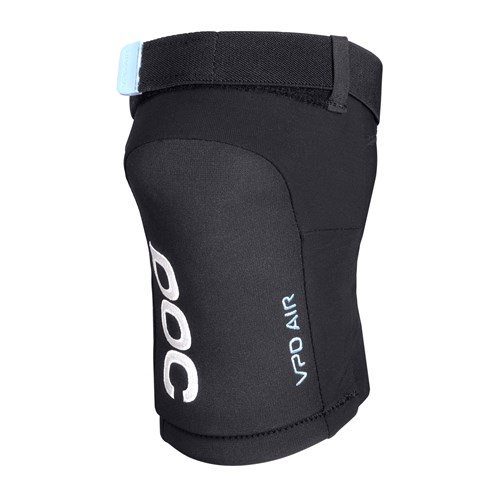
POC Joint VPD Air Knee Pads
Color: Uranium Black
Features:
- Low profile, slip-on design
- Neoprene anti-slip lining
- Reinforced stretch fabric
- Perforated pad for aided ventilation
- Certified with EN Standard 1621.1
MSRP: $80
Size Tested – Small & Medium
Blister’s Measured Weight:
Small: 135 & 138g (each)
Medium: 158 & 160g (each)
Intended Use: Trail/All-Mountain/Enduro
Days Tested: Small Pads: 10; Medium Pads: 15
Locations Tested: Santa Cruz, Bay Area, & Pacifica, CA; Ashland, OR; northern NM
A Little Background
I’ve always seen the appeal of knee pads, but I’ve rarely found myself wearing them outside the bike park since the most protective pads are usually the worst for pedaling, and a lot of the more pedal-friendly ones don’t offer enough protection to justify wearing them on a trail ride.
A lot of riders I know find themselves in this dilemma.
Fortunately, more protective products are coming out designed with both pedaling and harsh impacts in mind.
One such product is the POC Joint VPD Air Knee Pad. It joins POC’s lineup of bike armor, and brings the brand’s VPD technology to a lighter, more breathable, and more minimal-coverage package.

Blister’s editor-in-chief and I have both been testing the VPD Air Knee, so Jonathan is going to be chiming in on this review, too.
Design
The Joint VPD Air Knee is a slip-on pad that utilizes a single Velcro strap at the top of the pad to keep it in place. The sleeve of the pad is made of thin neoprene, which is designed to ventilate well while also keeping the pad in place. Ventilation is also aided by perforation in the VPD pad.
“VPD” stands for “visco-elastic polymer dough.” This is a material that shares properties with non-Newtonian fluids–they’re soft and malleable in most situations, but stiffen under a harsh impact.
POC and a few other brands have used non-Newtonian materials in their lighter pads in the past few years, and this type of construction has been praised as a good way to gain more protection from a comfortable and flexible pad.
That said, this is clearly still a lighter-use pad. Compared to the brand’s more park and DH-oriented pads–the Joint VPD 2.0 and the Joint VPD 2.0 DH– the VPD Air Knee pads cover a lot less surface area, prioritizing comfort and weight savings over all-out indestructibility and protection.
Within the actual protective area of the pad, there are two different segments of VPD material, which are joined together at an angle to fit over the top of the kneecap. POC decided to end the coverage there, with little attention to the sides of the kneecap or top of the shin.
Despite being smaller and lightweight, the Joint VPD Air still meets EN Standard 1621.1 – Europe’s universal standard of impact diffusion for bike armor.
It’s worth noting, however, that this doesn’t mean that the Joint VPD Air is equally protective as the brand’s other pads just because they all uphold the same impact-diffusion standard. An EN 1621.1 rating is only a statement of the pad’s ability to diffuse a dead-on impact, and says nothing about overall coverage or durability.
NEXT: Fit, Comfort, and Performance

Nice review, ordered knees and elbows. Hope they will fit well. Cheers guys.
Great reviw, i`ve made my mind, i will order both knee and elbows pads from POC, thank you guys, keep it up :-)
The Leatt 3DF Airflex has some side protection. Would you say that the Airflex offers better protection in a lighter package which breathes better in hot weather? Have you tried the 7iDp Sam Hill knee pads?
I was referring to the Airflex Pros